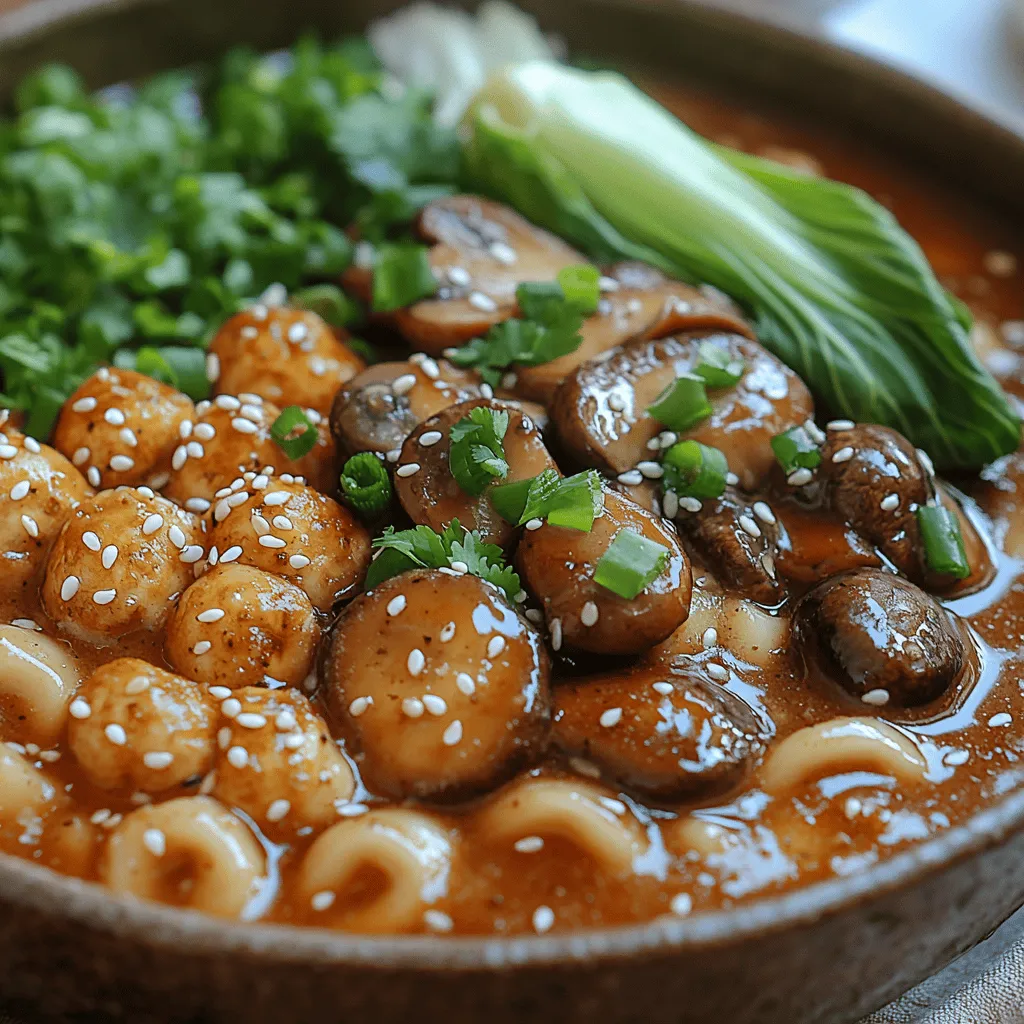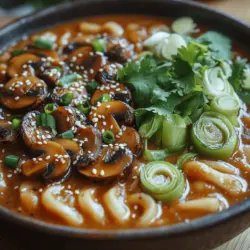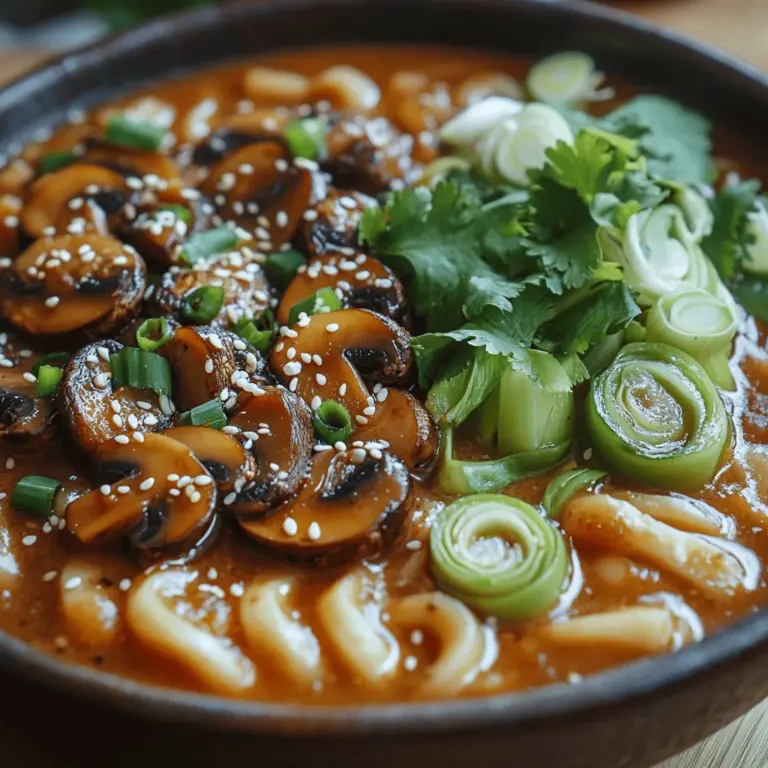Introduction
In a world where fast food often overshadows home-cooked meals, the significance of preparing your own recipes has never been more pronounced. The Earthy Miso Mushroom Udon is not just a dish; it’s an experience that encapsulates comfort, nutrition, and flavor in every bite. This Japanese-inspired noodle dish marries the umami richness of miso with the earthy notes of mushrooms, creating a hearty and satisfying meal. Whether you’re a seasoned home chef or a cooking novice, this recipe invites you to embrace the art of cooking while nourishing your body and soul.
Homemade recipes like the Earthy Miso Mushroom Udon offer many benefits in today’s fast-paced world. They provide a sense of accomplishment, a way to connect with loved ones, and the ability to control the ingredients that go into your meals. As we strive for healthier lifestyles, cooking at home becomes an essential tool in making mindful food choices. This dish not only celebrates the simplicity of fresh ingredients but also highlights the power of flavors that can be achieved through thoughtful preparation.
Let’s dive into the heart of the dish—its ingredients. The foundation of Earthy Miso Mushroom Udon includes udon noodles, a variety of mushrooms, miso paste, and fresh vegetables, each contributing unique flavors and nutritional benefits. Understanding these components will enhance your cooking experience and allow you to appreciate the dish on a deeper level.
Understanding the Main Ingredients
Udon Noodles
Udon noodles are thick, chewy Japanese noodles made from wheat flour, water, and salt. Their unique texture provides a satisfying bite and serves as the perfect vessel for absorbing flavors from the broth and sauces. Udon is not only delicious but also a versatile ingredient that can be used in various dishes—from soups to stir-fries. These noodles are typically served fresh or frozen, but dried udon is also available, making them accessible year-round.
Mushrooms
In this recipe, an assortment of mushrooms, such as shiitake, cremini, and oyster mushrooms, plays a crucial role. Mushrooms are low in calories yet packed with essential nutrients, including B vitamins, selenium, and antioxidants. Shiitake mushrooms are known for their rich umami flavor, while cremini mushrooms add a robust earthiness to the dish. Oyster mushrooms, with their delicate texture, provide a subtle sweetness that complements the other ingredients beautifully.
Miso Paste
Miso paste is a fermented soybean product that serves as a flavor powerhouse in this dish. It comes in various types, including white, yellow, and red miso, each offering different flavor profiles. White miso is sweet and mild, while red miso is more robust and salty. The fermentation process not only enhances the taste but also adds probiotics, contributing to gut health. Miso is rich in essential minerals and vitamins, making it a nutritious addition to any meal.
Fresh Vegetables
Incorporating fresh vegetables like bok choy, scallions, and carrots not only adds vibrant color but also contributes essential vitamins and minerals. Bok choy is a cruciferous vegetable that is low in calories and high in nutrients such as vitamin C, vitamin K, and folate. Carrots provide beta-carotene, an antioxidant that promotes eye health, while scallions add a mild onion flavor that enhances the overall taste of the dish.
Healthy Fats
To elevate the flavor profile, healthy fats such as sesame oil or olive oil are used in the cooking process. These fats not only help in sautéing ingredients but also carry flavors and provide a satisfying mouthfeel. Healthy fats are crucial in a balanced diet, aiding in the absorption of fat-soluble vitamins and contributing to overall health. Choosing the right oil can make a significant difference in the dish’s final taste.
Nutritional Benefits
The combination of udon noodles, mushrooms, miso, and fresh vegetables results in a nutrient-dense meal that supports overall well-being. Udon provides carbohydrates for energy, while mushrooms and vegetables offer an array of vitamins and minerals. The inclusion of miso delivers probiotics that enhance gut health, making this dish not only delicious but also beneficial for your digestive system.
Fresh vs. Dried Spices
Using fresh herbs and spices can significantly elevate the flavor of your dishes. Fresh ingredients tend to have a more potent aroma and taste compared to their dried counterparts. For example, fresh ginger has a bright, zesty flavor that can invigorate the dish. However, dried herbs and spices can also be used effectively, especially when fresh ingredients are unavailable. The key is to adjust the quantities accordingly, as dried spices are often more concentrated than fresh.
Preparation Steps
To embark on your culinary adventure of creating Earthy Miso Mushroom Udon, proper preparation is essential. Follow these detailed steps to ensure that your ingredients are ready for cooking:
Ingredient Preparation
1. Washing and Cutting Vegetables: Begin by thoroughly washing your vegetables under cold water to remove any dirt or impurities. For bok choy, separate the leaves and rinse well, then chop them into bite-sized pieces. For carrots, peel the skin and slice them into thin rounds or julienne them for a more elegant presentation. Scallions should be trimmed and sliced thinly, using both the white and green parts for added flavor and color.
2. Preparing the Mushrooms: Depending on the type of mushrooms you choose, the preparation may vary. For shiitake mushrooms, remove the stems and slice the caps into thin strips. For cremini and oyster mushrooms, simply slice them as well. Ensure that the mushrooms are clean; a damp cloth can be used to wipe away any dirt, as soaking them in water can cause them to become soggy.
3. Noodle Preparation: If you’re using fresh udon noodles, they may require minimal preparation—just a quick rinse under hot water to separate them. For dried udon, follow the package instructions for cooking time and method, typically boiling them in salted water until tender.
4. Marinating: Although the recipe may not require a lengthy marination, you can enhance the flavor of the mushrooms by briefly marinating them in a mixture of soy sauce, sesame oil, and a touch of miso. Allow them to sit for at least 10-15 minutes to absorb the flavors.
Tools and Equipment Needed
To make your cooking process smooth and efficient, gather the essential kitchen tools and equipment before you start. Here’s a list of items you’ll need:
– A large pot or wok for cooking the noodles and stir-frying the ingredients.
– A cutting board and sharp knife for chopping vegetables and mushrooms.
– A mixing bowl for preparing the marinade.
– Measuring cups and spoons for accurate ingredient portions.
– A colander for draining noodles after cooking.
– A spatula or wooden spoon for stirring and sautéing.
If you don’t have a wok, a large skillet can be an effective alternative. The key is to ensure that your chosen cooking vessel has enough surface area to allow for even cooking and sautéing.
Cooking Techniques
With your ingredients prepped and tools at the ready, it’s time to delve into the cooking techniques that will bring your Earthy Miso Mushroom Udon to life. Here’s a step-by-step guide to creating this delicious dish:
1. Cooking the Udon Noodles: If you’re using dried udon noodles, bring a large pot of salted water to a boil. Add the noodles and cook according to the package instructions, typically about 6-8 minutes for dried udon. Once cooked, drain and rinse under cold water to stop the cooking process. Set aside.
2. Sautéing the Vegetables: In a large wok or skillet, heat a tablespoon of sesame or olive oil over medium-high heat. Add the sliced carrots and sauté for about 2-3 minutes until they begin to soften. Next, add the chopped bok choy and continue to stir-fry for another minute until wilted. Finally, toss in the prepared mushrooms and sauté until they are tender and golden brown, about 4-5 minutes.
3. Building the Flavor: Once the vegetables are tender, lower the heat slightly and add the miso paste to the pan. Use a spatula to mix it in with the sautéed vegetables, allowing it to dissolve and coat everything evenly. If the mixture appears too thick, you can add a splash of vegetable broth or water to achieve your desired consistency.
4. Combining Ingredients: Add the cooked udon noodles to the wok, tossing them gently with the sautéed vegetables and miso mixture. Ensure that the noodles are evenly coated with the sauce and heated through. This step is crucial for ensuring that every bite is infused with the rich flavors of the dish.
5. Final Touches: Once everything is heated through, sprinkle the sliced scallions over the top and gently toss to combine. Allow the dish to cook for an additional minute to meld the flavors together.
6. Serving: Serve your Earthy Miso Mushroom Udon hot, garnished with additional scallions or a sprinkle of sesame seeds for added texture and flavor.
By following these cooking techniques, you will achieve a dish that not only looks appealing but also bursts with flavor and texture. The combination of sautéed vegetables, tender udon noodles, and the rich umami from the miso creates a satisfying meal that is sure to impress.
As you embark on this culinary journey, remember that cooking is as much about enjoyment as it is about nourishment. Embrace the process, savor the aromas, and relish the opportunity to create something truly special.

How to Know When the Dish is Perfectly Cooked
The key to achieving a perfectly cooked Earthy Miso Mushroom Udon lies in the balance of flavors and textures. As you approach the final stages of cooking, look for the following indicators:
– Noodles: Udon noodles should be tender yet firm, commonly referred to as “al dente.” Taste a noodle to check; it should have just enough bite without being overly chewy. Typically, udon noodles take about 8-10 minutes to cook through, but this can vary based on the brand and thickness.
– Mushrooms: The mushrooms should be soft and slightly caramelized, having absorbed the umami flavors from the miso and broth. They should not be mushy; a light sear will enhance their earthy flavor.
– Broth: The broth should be rich and flavorful but not overly salty. It should have a pleasant aroma, with the miso and garlic melding beautifully. If the broth has thickened too much, add a splash of water or vegetable stock to adjust the consistency.
– Vegetables: If you’ve added vegetables, they should be vibrant and tender-crisp. Overcooked vegetables can lose their nutrients and flavor, so aim for a cook time that maintains their color and texture.
Adjusting Seasoning and Flavors During Cooking
Cooking is an art, and every palate is unique. As you prepare your Earthy Miso Mushroom Udon, don’t hesitate to adjust the seasoning to suit your taste. Here are some tips to enhance the flavor profile:
– Taste as You Go: As you add ingredients, especially miso, sample the dish periodically. Miso can vary in saltiness, so starting with less and adding more to taste is wise.
– Balance Flavors: If the broth tastes too salty, you can add a splash of rice vinegar or a squeeze of lime juice to brighten it up. On the other hand, if it lacks depth, consider adding a dash of soy sauce or sesame oil for added umami.
– Herbs and Spices: Fresh herbs like cilantro, green onions, or even a pinch of chili flakes can elevate the dish. Add these right at the end of cooking to preserve their freshness.
Serving Suggestions
When it comes to serving Earthy Miso Mushroom Udon, presentation and pairing can enhance the dining experience. Here are some suggestions:
– Pairing Ideas: This dish pairs beautifully with light accompaniments. Consider serving a side salad with sesame dressing or steamed bok choy seasoned with a sprinkle of soy sauce. A simple cucumber salad can also provide a refreshing contrast.
– Recommended Sides: For a heartier meal, consider serving with side dishes like edamame, tempura vegetables, or Japanese pickles (tsukemono). These options add texture and flavor without overwhelming the udon.
– Sauces and Dips: A side of soy sauce or a light ponzu dip can complement the udon’s flavor. Alternatively, for those who enjoy spice, a drizzle of sriracha or a dollop of chili oil can add a kick.
– Presentation Tips: For an appealing plate, use deep bowls to allow the broth to shine. Garnish with chopped green onions, a sprinkle of sesame seeds, or a few sprigs of cilantro. Arrange the mushrooms artfully on top and consider adding a lime wedge for a pop of color.
– Garnishing and Plating Techniques: Use a light hand when garnishing to avoid overwhelming the dish. A well-placed herb or sprinkle of seeds can transform the presentation from simple to stunning.
– Serving Styles: This dish can be served family-style in a large bowl, allowing guests to help themselves, or plated individually for a more formal presentation. Both styles encourage sharing and conversation, enhancing the dining experience.
Variations and Customizations
One of the joys of cooking is the ability to customize recipes to fit your preferences or dietary needs. Here are some variations and customizations you can consider for your Earthy Miso Mushroom Udon:
– Exploring Variations: You can experiment with different types of mushrooms, such as shiitake, oyster, or even a mix, to create a unique flavor profile. Each variety brings its own texture and taste, adding depth to the dish.
– Vegetarian or Vegan Alternatives: This recipe can easily be made vegan by using vegetable broth and ensuring that the miso is free from any fish products. You could also substitute tofu for mushrooms or add more vegetables like zucchini or bell peppers.
– Ingredient Substitutions: If you don’t have udon noodles on hand, feel free to substitute with soba or rice noodles. Adjusting the cooking time based on the type of noodle is crucial to maintain the right texture.
– Cultural Adaptations: This dish can take on different cultural influences. For example, adding kimchi for a Korean twist or incorporating Thai basil for a Southeast Asian flavor can create exciting new versions of this udon recipe.
– Similar Dishes: Explore similar dishes from around the world, such as Japanese ramen, Korean jjigae, or even a Chinese noodle stir-fry. Each cuisine offers its own take on noodle dishes, providing inspiration for future meals.
Storing and Reheating
If you find yourself with leftovers or want to meal prep, here are some best practices for storing and reheating your Earthy Miso Mushroom Udon:
– Storing Leftovers: Allow the udon to cool completely before transferring it to an airtight container. The noodles tend to absorb broth, so consider storing the broth separately if possible.
– Refrigeration and Freezing: Store leftovers in the fridge for up to 3 days. If freezing, use freezer-safe containers, but keep in mind that the texture of the noodles might change upon thawing.
– Maintaining Flavor and Texture: To maintain the quality, avoid reheating udon multiple times. Instead, reheat only what you plan to eat, and add a splash of broth or water to help restore moisture.
– Reheating Methods: For reheating, the stove is the best option. Place the udon and broth in a saucepan over medium heat, stirring occasionally until heated through. If using a microwave, cover the bowl with a microwave-safe lid or plate, adding a little water to prevent drying out.
– Recommended Techniques: If you have a large batch, consider using the oven or stovetop to reheat on low heat, ensuring even warming without overcooking the noodles.
Conclusion
The Earthy Miso Mushroom Udon is not just a comforting meal; it’s a versatile dish that invites creativity and personalization. From adjusting seasonings to exploring variations, you can make this recipe your own while enjoying the nourishing flavors of miso and mushrooms.
Whether you choose to pair it with refreshing sides or adapt it to fit various dietary preferences, this udon dish stands out as a delightful culinary experience. We encourage you to try this recipe and explore its many variations, embracing the joy of cooking and the satisfaction of sharing homemade meals with loved ones. Happy cooking!

